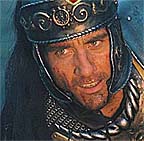 Well, I took off work early yesterday so I could see Bruckheimer's new King Arthur on opening day. I liked this new darker version of Arthur and his knights although I felt the film suffered from some bad film editing trying to fit it into a shorter time slot than it deserved. I think there should have been a more in-depth introduction of characters and examples of experiences that resulted in their bonding as a combat unit and brotherhood that occurred over time as they served together. The film opens with Lancelot being "drafted" and taken from his Sarmatian family as a youth. Then the film jumps ahead 15 years and Arthur and his battle-hardened cavalry are seen riding to the rescue of a bishop traveling to a fort along Hadrian's wall. There is an obvious bond between the men but the viewer is not given any background for this close bond or the legendary exploits that others in the film refer to.
Well, I took off work early yesterday so I could see Bruckheimer's new King Arthur on opening day. I liked this new darker version of Arthur and his knights although I felt the film suffered from some bad film editing trying to fit it into a shorter time slot than it deserved. I think there should have been a more in-depth introduction of characters and examples of experiences that resulted in their bonding as a combat unit and brotherhood that occurred over time as they served together. The film opens with Lancelot being "drafted" and taken from his Sarmatian family as a youth. Then the film jumps ahead 15 years and Arthur and his battle-hardened cavalry are seen riding to the rescue of a bishop traveling to a fort along Hadrian's wall. There is an obvious bond between the men but the viewer is not given any background for this close bond or the legendary exploits that others in the film refer to.
In Gladiator, Ridley Scott illustrates the relationship between Maximus and his men in the opening sequence. You can almost read Maximus' thoughts as he fingers the wheat, smiles at the bird, then his face hardens as he thinks about the battle to come. He passes down the line of his troops, sharing quips, patting armor, obviously respected by his troops as a leader who has shared their lot. He and Quintus discuss the placement of the catapults, clearly establishing Quintus as the second in command and, when Quintus expresses concern about Maximus' safety, demonstrating he is obviously bonded to Maximus as well.
Arthur's director, Antoine Fuqua, leaves the audience guessing about the knights and their relationships to themselves and Arthur. A special relationship between Lancelot and Arthur is slightly inferred but not demonstrated well enough to bring the appropriate level of pathos to the final scenes. Several times throughout the film, Fuqua seems to almost pause the action for a "Kodak" moment. The pauses are so noticeable that I felt they interrupted the flow of the narrative although I must admit I didn't mind at all having a long look at Clive Owen in his Roman attire.
I also thought the sequence where Arthur discovers a Roman noble's bodyguards bricking up a dungeon where Guinevere is being starved to death by monks for her pagan ways while everyone else is fleeing to escape the Saxons (whose drums are heard loudly in the background) a bit contrived. I think it would have been more natural for Arthur and Guinevere to have come into conflict on opposing sides, with Arthur a witness to her warrior skills, then have Arthur get to know her on a personal level when the two sides join to fight the Saxons. As it is, Guinevere is near death when Arthur rescues her. She recovers rather quickly, then is hardly challenged when she announces she is staying with the knights in their delaying action on the frozen lake. Again, I felt there was some insightful film footage that ended up on the cutting room floor. Even so, Guinevere is in a feminine flowing gown during that battle. Later when the Saxons attack the fort, a Guinevere covered with tattoos and sporting a skimpy leather bikini charges into battle and the knights hardly notice the difference.
Of course, I was also a little taken aback that Stellan Skarsgard, my sweet Theseus from the Helen of Troy miniseries, could be such a hardened, merciless warrior.
Overall, however, I liked this version of the Arthur legend better than the fairy tale world of Sir Thomas Mallory. The characters were much more human and believable in their vices and disillusionment that surely were experienced by many Britons during this period of cataclysmic upheaval.
No comments:
Post a Comment